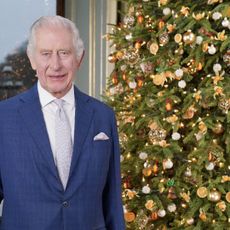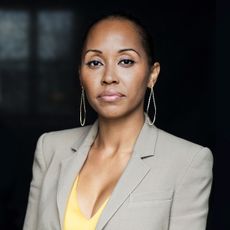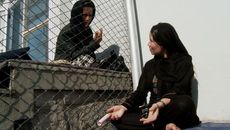Our Woman in Kabul
When danger struck, as it so often did in Afghanistan, Anne Smedinghoff, a young, up-and-coming diplomat with the State Department, shrugged it off, e-mailing friends and family that all was OK. Until one day in April, when it wasn't.

IT WAS 10 A.M. ON APRIL 6, 2013, when Mary Beth Smedinghoff's cell phone rang. A day earlier, she and her husband, Tom, had driven 10 hours from their home in suburban Chicago to Carlisle, Pennsylvania, where they were visiting their daughter Joan, a sophomore at nearby Dickinson College and the youngest of their four children. The couple were just getting ready to leave their room at the Days Inn when they got the call. Without picking up, Mary Beth knew it was about their eldest daughter, Anne. Any call from a 202 area code—Washington, D.C.—had to be about Anne, a State Department diplomat stationed at the U.S. Embassy in Kabul, Afghanistan. When an operator indicated that the call was from the State Department, Mary Beth muttered, "This can't be good."
Moments later, she was connected to John Kerry, the secretary of state. Kerry was scheduled to leave for Istanbul on official business, but he had kept his plane idling at Andrews Air Force Base in Maryland until he could connect with the Smedinghoffs. Just two weeks earlier, he'd paid a surprise 24-hour visit to Kabul, during which time Anne Smedinghoff, just 25 and a rising star in the Foreign Service, acted as an aide and guide. It was a plum role, the kind usually reserved for senior embassy officials, but "Ambassador Anne," as her colleagues dubbed her, had so impressed her supervisors with her unflappable and enterprising mien that nobody thought twice about giving her the task.
Kerry provided scant details to the Smedinghoffs, save for the most important: There's been an explosion … A suicide bomber … Six killed … "[Kerry] told us that she was calm," Tom recalls. "They got her on a stretcher and into a helicopter. She was still alive when they got to the hospital. They lost her there."
Smedinghoff, an assistant information officer, was the first American diplomat killed on the job since the deadly attack on the U.S. Embassy in Benghazi, Libya, seven months earlier. And like that incident, which resulted in the death of U.S. Ambassador Christopher J. Stevens and three other Americans, questions have emerged about the security measures in place the morning that Smedinghoff, traveling some six hours away from the embassy, was killed: Why was a civilian noncombatant operating so far beyond the embassy compound and the protection it provided? Was she adequately trained for that kind of excursion? But such questions, should they ever be answered, belie the bigger question, one rarely asked by those still reeling from the loss but which serves as the through line for Smedinghoff's brief but brilliant life: Why would a young woman who could have worked anywhere opt to work in one of the most violent places on earth?
UNTIL SHE LEFT for Johns Hopkins University at 18, Anne Smedinghoff lived in the same house in River Forest, Illinois, an upscale suburb some 10 miles outside of Chicago, all her life. But hers was no cloistered existence. At Fenwick High School, where she ran cross-country, studied Spanish, and participated in the Catholic school's campus ministry, a senior trip to London opened her eyes to the possibilities that lay in wait beyond her hometown. "She always did have a sense of adventure," says her mother. "From an early age, she had a calm and poise about her. She was not one to get rattled by things."
Smedinghoff majored in international relations at Johns Hopkins and toyed with attending law school, but she abandoned those plans after an internship at the Department of Justice. By the end of her senior year, Smedinghoff had taken the State Department's grueling written exam and aced the interviews designed to weed out the serious from the merely adventurous. The Foreign Service generally accepts older candidates, those seasoned by professional experience, but the 5'8", chestnut-haired Smedinghoff displayed an uncommon maturity and commitment for her age. Shortly after graduating, she moved to D.C. to begin nine weeks of training as a Foreign Service officer.
Her first posting was in 2010 in Caracas, Venezuela, where she served in the consulate, conducting roughly 100 visa-application interviews a day. Her quiet but commanding presence so impressed her supervisors that she was quickly tapped to check up on Americans incarcerated in Venezuelan prisons. Inmates, many of them members of drug cartels, all but control the prison system and are frequently armed. "It's an intimidating experience," says Amiee McGimpsey, who served with Smedinghoff in both Venezuela and Afghanistan, and who currently works as a liaison officer for the State Department in Kabul. "It's a very uncontrolled environment. But Anne was always completely fearless. She did it because it needed to be done."
Stay In The Know
Get exclusive access to fashion and beauty trends, hot-off-the-press celebrity news, and more.
While many Foreign Service workers use their vacation time to relax or visit family back home, Smedinghoff indulged her growing appetite for adventure. On one holiday, she biked across western Australia; on another, she trekked through the jungles of southern Venezuela, posting a picture on Facebook of an anaconda draped across her shoulders.
The intensity of Smedinghoff's work left little time for romance—not that there weren't plenty of suitors. (According to close friends, she'd broken up with a college boyfriend by the time she graduated and hadn't dated anyone since.) "Anne was beautiful, and there were a lot of people who showed interest," says Tom Hwei, who served with her at the embassy in Caracas, and who now works in Washington, D.C., for the State Department's Bureau of International Information Programs. "Guys would ask her out. She was this rare mixture of grace and charisma, but she was also intelligent with a really good work ethic. I have never seen somebody reject a guy so effectively, without the guy feeling hurt."
As her two-year stint in Caracas wound down, Smedinghoff considered her next career move. By then she'd already been identified by her superiors as a State Department standout. "Superlatives are the rule for describing her work," read one of Smedinghoff's evaluations in Caracas. "She is a star among her peers. Anne will continue to excel in whatever assignment she undertakes in the future; that's a given. She should indeed be tenured without delay and promoted as soon as possible. Her talents are so formidable that she will rise rapidly."
Friends and family encouraged her to apply for postings in Paris or London, but Smedinghoff turned up her nose at such cushy assignments. She'd already made up her mind to apply for a job in Kabul. Adds Smedinghoff's mother, Mary Beth, "I remember saying, 'Anne, why do you want to go there?' She said, 'It's just a one-year position. I don't need to learn a new language to go.' She saw Kabul as a good opportunity … She was fulfilling her calling. How do you stop someone from doing what she is called to do?"
In May 2012, Smedinghoff began training for the assignment in Washington, D.C. In addition to studying U.S. political and military strategy in Afghanistan, as well as the geopolitical issues plaguing the region, Smedinghoff was required to take courses in defensive driving, countersurveillance, weaponry, and emergency first aid. She arrived in Kabul two months later. Her duties included organizing press conferences, handling local and international media, and crafting talking points for speeches by James Cunningham, the new U.S. ambassador to Afghanistan. (Cunningham, who would not comment for this story, paid tribute to Smedinghoff at a memorial service in April: "The work we do is always difficult, sometimes dangerous, and occasionally deeply frustrating. But we do it because we believe it makes a difference. Anne loved her work and put her heart and soul into it. She was special.")
One of Smedinghoff's first assignments was drafting a press release about the death of Ahmad Khan Samangani, a prominent Afghan politician who was killed in a suicide bombing at his daughter's wedding. Such violence was commonplace in Kabul, and from her perch in the press office, Smedinghoff was privy to it all. Whenever a particularly deadly incident made headlines, Smedinghoff dashed off e-mails to friends and family, writing "I'm OK" in the subject line. "She once talked about being in a Black Hawk helicopter and being shot at," says friend Liz Meinert, her former roommate at Johns Hopkins. "She never expressed fear, and she never expressed worry. This was her dream."
In Afghanistan, Smedinghoff lived in a cramped, prefabricated "containerized housing unit"—called a hooch—that was relatively secure behind the compound walls. In e-mails, she described the heavy workload (16-hour days, six days a week) and how she and her coworkers spent their lone night off. This from a group e-mail sent one month after her arrival:
Thursday nights are the big nights at the Duck and Cover bar on compound. On Fridays I sleep in late and then go eat burgers by the pool for lunch. (This burger special is referred to as "Fresh Meat Fridays"—if you order a burger any other day of the week, it's a frozen patty that they reheat on the grill for you, but on Fridays they bring in fresh ground beef patties.) Then I do laundry, hit the gym, wander through the bazaar they bring onto compound (I may leave here with a lot of carpets …), and meet up with friends for dinner and relaxing around the outdoor fire pit. On Saturday it's back to the grind!
The "grind" suited Smedinghoff especially well. There were endless opportunities to assist the local population while also raising her profile at the embassy and beyond. She helped organize an embassy soccer club to provide an opponent for the Afghan women's national team—a fledgling, perilous affair in a culture that frowned upon such activity. Smedinghoff, who had a keen gift for cutting through red tape, was well-liked by her superiors and routinely tapped for tasks that required her to venture beyond the safety of the Kabul complex. "I was under the impression that she was going to be working on the embassy compound," says Smedinghoff's father. "But she posted a picture on Facebook that was clearly taken outside the embassy. The next time I talked to her, I said, 'What were you doing outside?' She said, 'Don't worry, Dad. That was from an armored vehicle. I wasn't just walking around the streets.' Several months later, I saw a picture of her and a coworker at a soccer game. It didn't look like they had any protection. We didn't really discuss it. She never expressed concerns about it." (From a State Department spokesperson: "No one made risky excursions. All trips were approved in advance and safety considerations taken into account.")
Whether or not this discretion was part of her job description or proof of how comfortable Smedinghoff had become with taking on more risk, no one can say for sure. But at a later memorial service in D.C., a former colleague of Smedinghoff's related an incident to her father suggesting just how dangerous her job had become: "He said, 'When the bullets were flying, Anne was the only one who was coolheaded, thinking about the safety of the ambassador.'"
When Secretary of State Kerry arrived in Kabul on March 25, embassy officials pulled Smedinghoff away from her regular obligations to support the high-profile visit. Not only did she escort the secretary, but she also handled logistics for a critical meeting between Kerry and Afghan President Hamid Karzai. At the end of Kerry's trip, as the secretary made his way to the helicopter that would transport him to the airport, the embassy photographer discovered that she didn't have the proper clearance to join Kerry for the ride. It was a major snafu: There would be no photos of Kerry's departure from his first trip to Afghanistan as the top U.S. diplomat. But no one panicked. "Anne was the first person I thought to call," says Beth Howard, one of Smedinghoff's colleagues. "She had all the info we needed. She got the photographer on that helicopter."
On the morning of April 6, Smedinghoff joined a convoy bound for a school in Qalat, the capital of Zabul province, a six-hour drive from Kabul. She was escorting Afghan journalists covering the My Afghan Library program, a joint initiative of Scholastic, the State Department, and the Afghan Ministry of Education that provides classroom texts in the Pashto and Dari languages to children. (Since 2011, My Afghan Library has distributed 2.3 million books to 27 of Afghanistan's 34 provinces.) Though the Taliban operated in the area, it was still generally considered safe for the visit from Smedinghoff and her group. The FBI and the State Department are investigating what exactly happened when the group arrived in Qalat and have released few facts. What is known is that Smedinghoff and the soldiers with her approached a gate leading to an all-boys school called Sheikh Mahdi, but it was blocked. Meanwhile, another convoy drew near carrying Mohammad Ashraf Naseri, the governor of Zabul province and a Taliban target. Just as Naseri's convoy crossed paths with Smedinghoff's group, a suicide bomber approached and detonated his load. It's unclear what injuries Smedinghoff initially sustained or when exactly she died.
The day after her death, Kerry addressed reporters at the U.S. Consulate General in Istanbul, saying, "Everything that our country stands for, everything we stand for, is embodied in what Anne Smedinghoff stood for. I remember her—vivacious, smart, capable, chosen often by the ambassador there to be the lead person because of her capacity." These have been his only official comments on Smedinghoff's death. The State Department won't say when it will issue a full report about the incident—or whether one will be made public at all. At an intimate memorial service at the embassy in Kabul before her body was transported back to the U.S., her colleagues gathered to eulogize her. "We grieved like a family," remembers Solmaz Sharifi, a fellow member of the press office. Several coworkers then accompanied her flag-draped casket to the Kabul airfield, where she received full military honors before her remains were flown the nearly 7,000 miles back home to Chicago. It was the type of ceremony that Smedinghoff herself had arranged many times before.
-
 The Cast of 'The Sex Lives of College Girls' Proved Just How Quickly They Bonded This Season
The Cast of 'The Sex Lives of College Girls' Proved Just How Quickly They Bonded This SeasonAlyah Chanelle Scott, Pauline Chalamet, Gracie Lawrence, and Mia Rodgers play 'How Well Do You Know Your Co-Star?'
By Quinci LeGardye Published
-
 Why Kate Middleton and Prince William's Decision to "Take the Lead" Is a "Relief" For King Charles, Royal Expert Explains
Why Kate Middleton and Prince William's Decision to "Take the Lead" Is a "Relief" For King Charles, Royal Expert Explains"We have had a glimpse of the future..."
By Amy Mackelden Published
-
 Buckingham Palace Responds After Royal Family Maid Is Arrested at "Out of Control" Christmas Party
Buckingham Palace Responds After Royal Family Maid Is Arrested at "Out of Control" Christmas Party"I've never seen one person get that crazy during a night out," a source claimed.
By Amy Mackelden Published
-
 Military Leaders Want Women to Register for the Draft
Military Leaders Want Women to Register for the DraftTop generals say it's only fair.
By Megan Friedman Published
-
 This Woman Risks Her Life to Ensure Justice Is Served in Afghanistan
This Woman Risks Her Life to Ensure Justice Is Served in AfghanistanMeet Kimberley Motley, the first foreign litigator working in Afghanistan's criminal courts.
By Feifei Sun Published
-
 Congressman Out to Personally Prove Women Couldn't Possibly Graduate from Ranger School
Congressman Out to Personally Prove Women Couldn't Possibly Graduate from Ranger SchoolShouldn't you be making laws or something?
By Megan Friedman Published
-
 A Scary Look at What Life Is Like for Women in Military Academies
A Scary Look at What Life Is Like for Women in Military AcademiesFrom blatant sexism to sexual assault.
By Megan Friedman Published
-
 "Love Crimes of Kabul"
"Love Crimes of Kabul"A new HBO documentary goes inside Afghanistan's Badam Bagh prison to profile women serving time for "moral crimes"
By Abby Gardner Published